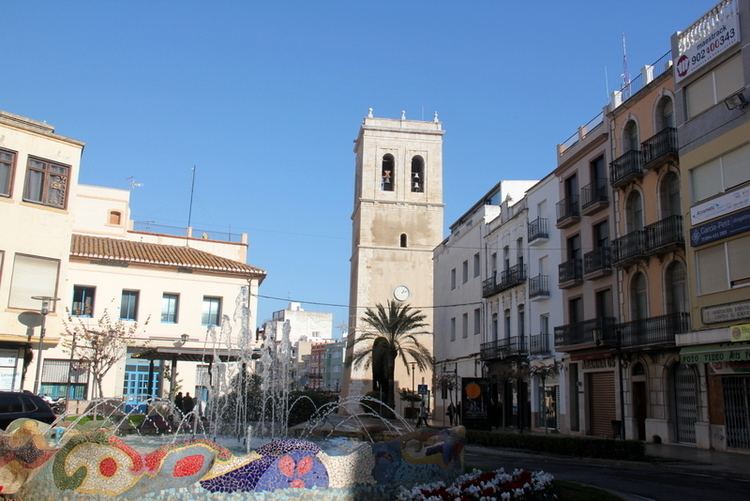Demonym(s) Vinarossenc Area 96.5 km² | Elevation 7 m (23 ft) Time zone CET (UTC+1) Population 28,337 (2014) Local time Monday 7:30 PM | |
 | ||
Weather 19°C, Wind S at 13 km/h, 44% Humidity | ||
Das efx in vinar s spain
Vinaròs ([vinaˈɾɔs]) is a city located in eastern Spain and the capital of the Baix Maestrat. It's in the province of Castellón, so it's part of the Valencian Community. Vinaròs is a fishing harbour and tourist destination.
Contents
- Das efx in vinar s spain
- Map of 12500 VinarC3B2s CastellC3B3n Spain
- Carnival
- History
- Main sights
- Politics
- People
- References
Map of 12500 Vinar%C3%B2s, Castell%C3%B3n, Spain
Carnival
The "Carnaval de Vinaroz" will take place from 17 until 27 February 2017. This event usually take place during January, February or Mars. The Carnival has 33 troupes which are composed of lots of people (The biggest troupe has around 550 components). Each troupe is represented by a queen who creates a spectacular costume.
CALENDAR
1st day (Friday): in the Town Hall, Carnival starts by a performance decorated with the Carnival's topic (In 2017 "Bollywood") and the "Carnestoltes" presentation ("Carnestoltes" is a huge man made by a wood structure and dressed by a costume suitable with the Carnival's Topic). Then, the Mayor and the queens open the Carnival's hutts enclosure (Placed in the Fóra Forat Walk where all nights parties take place in. Each troupe has got a hut where you can go into by free and enjoy night parties).
2nd day (Saturday): The Queen's Presentation, where they show their fantastic costumes to all the people (Until this day, anyone knows how queen's costumes will be like). It's located on the old football pitch (Boverals H street / Football pitch street. It's placed in front of the river).
3rd day (Sunday): Flour's battle and Disguised pets Competition in the Carnival's hutts enclosure (Fóra Forat Walk), placed in the Fóra Forat Walk both.
4th day (Monday): elderlies' dinner.
5th day (Tuesday): some troupes fight for win the Karaoke Song Contest.
6th day (Wednesday): people dress up with thematic costumes that are suitable with the Carnival's Topic and they enjoy the night at the Carnival's hutts enclosure (Fóra Forat Walk).
7th day (Thursday): all people dress up with pyjamas and enjoy the night at the Carnival's hutts enclosure (Fóra Forat Walk).
8th day (Friday): people dress up costumes (There are people who, instead of buying a normal costume, designs, make and sew up their own one) and enjoy the night at the Carnival's hutts enclosure (Fóra Forat Walk).
9th day (Saturday) and 10th day (Sunday): on Saturday (7 p.m.) and Sunday (6 p.m.), troupes parade around the main streets in a closed route (Calle Pilar, Calle Pablo Ruiz Picasso, Calle San Francisco, Avenida País Valencià, Calle Arcipreste Bono, Plaza 1º de Mayo, Calle Costa y Borrás, Avenida País Valencià, Calle Arcipreste Bono, Calle Socorro, Plaza Jovellar and Calle Pilar).
11th day (Monday): Carnival ends at the Town Hall and then the "Carnestoltes" is burned in the beach or in a waste ground.
Moreover, in August there's the Summer Carnival with The Queen's Presentation to show the tourists how Carnival is like in Vinaròs.
History
The first historical record of Vinaròs is in 1233, when the Moorish hamlet of Binarlaros-Ibn Arus in eastern al-Andaluz was captured by King James I of Aragon. It was under rule of the Knights templar order between 1294 and 1311, and of the order of Montesa during the 14th century.
The town grew during the 16th and 17th centuries, when fortifications and navy yards were built, and attained great prosperity during the following two centuries, due to its involvement in ship building and Valencian wine trade. The town suffered a strong decline in the early 20th century as a consequence of the spread of phylloxera in the regions vineyards, which devastated wine production.
Today, the prosperity of Vinaròs is bound to tourism and fishing, it is renowned for its tasty prawns. Vinaròs is part of the Taula del Sénia free association of municipalities.
Main sights
Sights in Vinaròs is the fortress-like Església Arxiprestal de l'Assumpció (Archpriestal Church of the Assumption of Our Lady), built in the prevailing Renaissance architectural style during 1583-1596, with a 'new' Baroque portal added during 1698–1702.
Politics
In the 2007 Spanish local elections, the People's Party got 10 city councillors, 7 more the PSPV-PSOE, 3 the Partit de Vinaròs Independent (PVI) and 1 the Valencian Nationalist Bloc.
In the 2011 Spanish local elections, the People's Party got the absolute majority obtaining 11 city councillors. The PSPV-PSOE got 6 city councillors, the Valencian Nationalist Bloc got 2 city councillors, the PVI lost two city councillors (they got 1 city councillor) and Republican Left of the Valencian Country got 1 city councillor.
In the 2015 Spanish local elections, the People's Party lost three city councillors, obtaining 8 city councillors. The PSPV-PSOE lost two city councillors (They got 4). The electors association Each and every one are Vinaròs (TSV) got 5 city councillors and the rest political parties keep the same number of city councillors (2 Commitment Coalition, 1 el Independent Party of Vinaròs and 1 Civic Agreement). The PSPV-PSOE, Commitment Coalition and Each and every one are Vinaròs (TSV) signed the "Stables Covenant" in order to form a government with absolute majority, that is with 11 city councillors (5 of TSV, 4 of PSPV-PSOE and 2 of Commitment Coalition). In this document, they agreed that the leader of the most voted list would be the mayor, Mr. Enric Pla Vall, and the other leaders would be the first and second deputy mayors depending on the elected city councillors they had. So the first deputy mayor was Mr. Guillem Alsina Gilabert from the PSPV-PSOE and the second one was Mr. Domènec Fontanet from Commitment Coalition.
